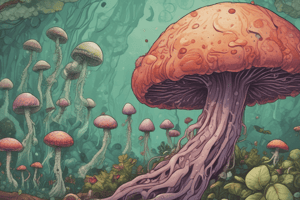Podcast
Questions and Answers
What is a characteristic of subcutaneous/deep mycoses?
What is a characteristic of subcutaneous/deep mycoses?
- They are very common in horses
- They involve subcutaneous tissues in addition to dermal/epidermal involvement (correct)
- They are easily diagnosed and treated
- They are not chronic and progressive
What is the site of infection for Trichophyton spp.?
What is the site of infection for Trichophyton spp.?
- Areas of deep skin trauma
- Hair follicles
- Areas of superficial skin trauma (correct)
- Muscle tissues
What is a common site of infection for Trichophyton spp.?
What is a common site of infection for Trichophyton spp.?
- Abrasions of rider's boots and girths (correct)
- Muscle tissues
- Abrasions of rider's boots
- Areas of superficial skin trauma
What is the primary method of diagnosis for Trichophyton spp.?
What is the primary method of diagnosis for Trichophyton spp.?
What is a treatment method for Trichophyton spp.?
What is a treatment method for Trichophyton spp.?
What is a method of control for Trichophyton spp.?
What is a method of control for Trichophyton spp.?
What is a characteristic of Microsporosis?
What is a characteristic of Microsporosis?
What is a common species of Microsporosis?
What is a common species of Microsporosis?
What is the primary mode of infection for Coccidioidomycosis?
What is the primary mode of infection for Coccidioidomycosis?
What is the mode of survival of Microsporum gypseum in beddings and other materials?
What is the mode of survival of Microsporum gypseum in beddings and other materials?
What is the most common cause of Candidiasis in animals?
What is the most common cause of Candidiasis in animals?
What is the prognosis for horses with nerve damage from Candidiasis?
What is the prognosis for horses with nerve damage from Candidiasis?
What is the primary location of infection in Aspergillosis in horses?
What is the primary location of infection in Aspergillosis in horses?
What is the treatment for oral or skin candidiasis in horses?
What is the treatment for oral or skin candidiasis in horses?
What is the purpose of clipping off hair around defined lesions in the treatment of Microsporum gypseum infection?
What is the purpose of clipping off hair around defined lesions in the treatment of Microsporum gypseum infection?
What is the primary geographical location for Coccidioidomycosis infections?
What is the primary geographical location for Coccidioidomycosis infections?
What is the characteristic of the early lesions of Microsporum gypseum infection?
What is the characteristic of the early lesions of Microsporum gypseum infection?
What is the significance of sunshine in the treatment of Microsporum gypseum infection?
What is the significance of sunshine in the treatment of Microsporum gypseum infection?
What is the common sign of Coccidioidomycosis in horses?
What is the common sign of Coccidioidomycosis in horses?
What is the cause of arthritis in horses according to the text?
What is the cause of arthritis in horses according to the text?
What is the typical duration of spontaneous resolution of Microsporum gypseum infection?
What is the typical duration of spontaneous resolution of Microsporum gypseum infection?
What is the common presenting sign of Aspergillosis in horses?
What is the common presenting sign of Aspergillosis in horses?
What is the context in which epidemics of Coccidioidomycosis may occur?
What is the context in which epidemics of Coccidioidomycosis may occur?
What is the purpose of environmental disinfection in the treatment of Microsporum gypseum infection?
What is the purpose of environmental disinfection in the treatment of Microsporum gypseum infection?
What is the usual duration of antifungal treatment for rhinosporidiosis?
What is the usual duration of antifungal treatment for rhinosporidiosis?
Which of the following is a characteristic of rhinosporidiosis?
Which of the following is a characteristic of rhinosporidiosis?
What is the primary mode of transmission of Sporothrix schenckii?
What is the primary mode of transmission of Sporothrix schenckii?
What is a common symptom of rhinosporidiosis?
What is a common symptom of rhinosporidiosis?
What is the standard treatment for rhinosporidiosis?
What is the standard treatment for rhinosporidiosis?
Which of the following is a characteristic of sporotrichosis?
Which of the following is a characteristic of sporotrichosis?
What is a common site of infection for Sporothrix schenckii?
What is a common site of infection for Sporothrix schenckii?
What is a possible complication of chronic sporotrichosis?
What is a possible complication of chronic sporotrichosis?
What is the typical location of nodule development in epizootic lymphangitis?
What is the typical location of nodule development in epizootic lymphangitis?
What is the characteristic of the yeast forms in epizootic lymphangitis?
What is the characteristic of the yeast forms in epizootic lymphangitis?
What is the primary method of preventing the spread of epizootic lymphangitis?
What is the primary method of preventing the spread of epizootic lymphangitis?
What is the common environment where Pythium insidiosum can persist?
What is the common environment where Pythium insidiosum can persist?
What is the characteristic of the lesions in pythiosis?
What is the characteristic of the lesions in pythiosis?
What is the primary cause of pythiosis?
What is the primary cause of pythiosis?
What is the common behavior of horses affected by pythiosis?
What is the common behavior of horses affected by pythiosis?
What is the usual restriction of infections in horses with pythiosis?
What is the usual restriction of infections in horses with pythiosis?
Flashcards are hidden until you start studying
Study Notes
Subcutaneous/Deep Mycoses
- Involve subcutaneous tissues in addition to dermal/epidermal involvement
- Can be localized or spread insidiously to contiguous tissues and via lymphatic vessels
- Difficult to diagnose and treat, with seroconversion leading to chronic and progressive disease
- More serious but geographically restricted, and rare or very rare in horses
Trichophytosis
- Caused by Trichophyton spp.
- Very common cutaneous mycosis worldwide
- Spores highly resistant, leading to repeated infections in stables/yards
- Requires epidermal damage to gain entry and remain in follicles of hair shafts
- Site of infection typically areas of superficial skin trauma (tack and harness contact points)
Clinical Signs of Trichophytosis
- Early signs: erect hairs, local swelling/edema, and mild exudate
- Advanced signs: complete shedding of hairs, lesions easily and completely epilated, leaving silvery exposed epidermis
- Common sites of infection: abrasions of rider's boots and girths
Diagnosis and Treatment of Trichophytosis
- Diagnosis: clinical signs, differential diagnosis with other fungal diseases, and biopsy
- Treatment: isolation of infected horse, hygiene and sanitation, topical antifungal washes, oral griseofulvin (not for pregnant mares), and use of fungicidal disinfectants
Control of Trichophytosis
- Vaccination in some countries
- Early recognition and isolation of infected horses
- Stable and personal hygiene
- Individualized tack, harness, and rugs
- Use of gloves
Microsporosis
- Caused by Microsporum spp.
- Less common than Trichophyton spp. infections
- Isolated lesions more common than extensive coalescing areas
- Pathogenesis same as trichophytosis
- Common species: M. equinum, M. canis, M. gypseum
Clinical Signs of Microsporosis
- Early signs: small expanding areas of localized edema resembling urticaria
- Advanced signs: early lesions with exudate and mildly pruritic, horse rubs affected areas but does not bite
- Plucking of hairs resented because not all hairs are affected
Diagnosis and Treatment of Microsporosis
- Diagnosis: clinical signs, cultures and microscopy of stained smears and hairs, and secondary urticarial-like plaques
- Treatment: local topical washes with fungicide, environmental disinfection, and sunshine (strong inhibitor of Microsporum spp.)
- Prognosis: excellent, most resolved spontaneously within 6-12 weeks
Aspergillosis (Guttural Pouch Mycosis)
- Fungal infection caused by Aspergillus species
- Primarily a respiratory infection that may become generalized
- Found worldwide in almost all domestic animals and many wild animals
- Susceptibility to fungal infections varies among species
- Most common form in horses: fungal disease affecting the guttural pouch
Clinical Signs of Aspergillosis
- Nosebleed and difficulty in breathing or swallowing
- Holding the head extended or low, head-shaking, swelling of the head, neurologic signs, and nasal discharge
Treatment of Aspergillosis
- Topical and oral antifungal agents
- Outlook: guarded, horses may survive but not recover completely, particularly if nerves are damaged
Candidiasis
- Localized fungal disease affecting mucous membranes and skin
- Caused by Candida albicans
- Distributed worldwide in various animals
- Most commonly seen in foals
- Signs: variable and nonspecific, may be associated with primary or predisposing conditions
Treatment of Candidiasis
- Ointment or topical application
- Different drugs given by mouth or through the vein to resolve arthritis or treat generalized candidiasis
Coccidioidomycosis (Valley Fever)
- Dustborne, noncontagious infection caused by Coccidioides immitis
- Limited to dry, desert-like regions of the southwestern United States and similar areas of Mexico and Central and South America
- Inhalation of fungal spores is the only established mode of infection
- Epidemics may occur when rainy periods are followed by drought, resulting in dust storms
Clinical Signs of Coccidioidomycosis
- Loss of weight, coughing, fever, musculoskeletal pain, and abscesses of the skin
- Nodules develop under the skin, increasing in size and undergoing cycles of granulation and partial healing
Diagnosis and Treatment of Coccidioidomycosis
- Diagnosis: microscopic examination of discharges from infected area or biopsy specimens
- Treatment: surgical removal of lesions combined with antifungal drugs, but no completely satisfactory treatment is known
- Strict hygienic precautions are essential to prevent spread
Pythiosis
- Disease caused by Pythium insidiosum, a water mold
- Occurs in tropical and subtropical areas of the world, seen in warmer sections of the US
- Infections in horses are most commonly restricted to the skin and tissues just inside the skin
- Large, circular nodules or areas of swelling can become open, draining sores
Treatment of Pythiosis
- Antifungal drugs may be considered in cases when surgery is not possible
- Antifungal treatment is long-term (6-12 months), expensive, and has variable results
Rhinosporidiosis
- Chronic infection, primarily of the lining of the nasal passages and occasionally of the skin
- Caused by Rhinosporidium seeberi
- Rarely fatal, and uncommon in North America
- Seen most often in India, Africa, and South America
Clinical Signs of Rhinosporidiosis
- Nasal discharge and sneezing
- Infection of the nasal mucosa is characterized by polyp-like growths
- Skin lesions may be single or multiple, attached at a base or have a stem-like connection
Treatment of Rhinosporidiosis
- Surgical removal of lesions is considered the standard treatment, but recurrence is common
Sporotrichosis
- Sporadic chronic disease caused by Sporothrix schenckii
- Organism is found around the world in soil, vegetation, and timber
- Infection usually results when the organism enters the body through skin wounds
- Transmission of the disease from animals to humans can occur
Clinical Signs of Sporotrichosis
- Small, firm nodules develop at the site where infection enters the body
- Although generalized illness is not seen initially, chronic illness may result in fever, listlessness, and depression
Studying That Suits You
Use AI to generate personalized quizzes and flashcards to suit your learning preferences.




